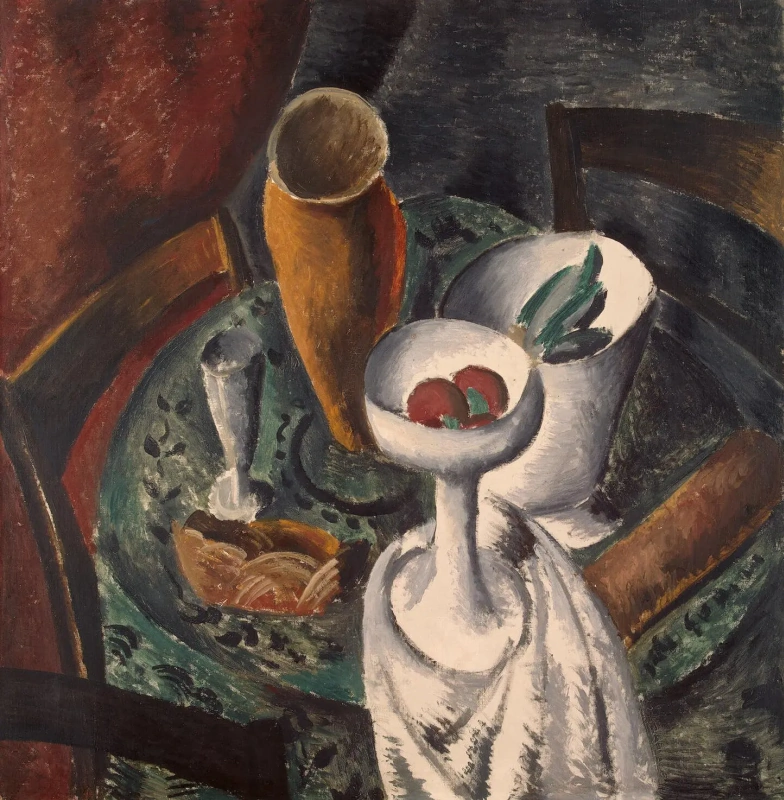log in
Enter site
Login to use Arthive functionality to the maximum
Table and chairs
Andre Derain • Peinture, 1912, 87×88.5 cm


















Descriptif de la toile «Table and chairs»
"Table and chairs" – one of several still lifes, showing the farewell of Darren with fovisticheskie tradition. The next step was the fascination with cubism, to be exact – Cezanne, which became the forerunner of cubism. The still life is easily recognizable dialogue with Cezanne. Traditional white tablecloth Cezanne, density, volume, weight of items, the restrained palette... Colorful riot of planar images fovisticheskie pores left behind. But then Cezanne "protocolize" Deren in this direction will not go. In life he was friends with Picasso and in the arts his fascination with cubism was short-lived. "It is impossible to reduce everything to straight lines... the curve of his cheek not like bending plates"– explained his departure from the ideas of cubism andré Derain.
In the still life "Table and chairs" highlighted the geometric shapes. A key recurring figure is a circle: a round table aimed visible from the top view circles vases and glasses, spherical fruit arranged in a circle of chairs. Interestingly, frog (left) is not shown on top and side. It is well within the scope of cubism, it was welcomed by multiple viewpoints.
The colour scheme is restrained and yet rich. Is dominated by three shades: variations of brown, gray-green and white-blue. It is also within the cubist tradition, but even in this minimalist color appeared subtle sense of color inherent Derain: the reddish hue of the vase, the warm tone of the chairs and Burgundy fruit, green flashes on the tablecloth and a crisp drape. The overall mood of the picture is slightly gloomy, in principle, inherent in many still lifes of cézanne and the paintings of the Cubists.
It is interesting to trace the evolution of still life in the genre of Andre Derain. If to consider one of the first still lifes, dated 1904, is striking some redundancy of objects: bottles, jugs, bowls, plates fruit. The artist only masters the subject and spatial properties that greedily combines different shapes, volumes, texture: crumpled tablecloth in the foreground is a bit messy cluster of variously shaped objects on the rear. It is already possible to guess the desire of the village to decoration, which in the next, 1905, will gain strength and will lead to the emergence of Fauvism. And yet it is only the combination of bluish spots on dishes and tablecloths, the cool green and a warm color suddenly on a plot of sun-drenched tablecloths, and red background, and red fruit.
The cubist still lifes of the period, among them considered here, a more concise and restrained. Like the artist decided to significantly reduce the number and variety of items to make a more restrained palette, uncluttered composition and give the image depth.
After the First world war Derain strongly turns to the classics. Later works written in the spirit of the old Museum still lifes. According to some researchers, he moved to "cold naturalism", but perhaps this is too subjective opinion. Moreover, the village does not aspire to be classified considering that "painting always remains the same – just painting".
Author: Alain Esaulova
In the still life "Table and chairs" highlighted the geometric shapes. A key recurring figure is a circle: a round table aimed visible from the top view circles vases and glasses, spherical fruit arranged in a circle of chairs. Interestingly, frog (left) is not shown on top and side. It is well within the scope of cubism, it was welcomed by multiple viewpoints.
The colour scheme is restrained and yet rich. Is dominated by three shades: variations of brown, gray-green and white-blue. It is also within the cubist tradition, but even in this minimalist color appeared subtle sense of color inherent Derain: the reddish hue of the vase, the warm tone of the chairs and Burgundy fruit, green flashes on the tablecloth and a crisp drape. The overall mood of the picture is slightly gloomy, in principle, inherent in many still lifes of cézanne and the paintings of the Cubists.
It is interesting to trace the evolution of still life in the genre of Andre Derain. If to consider one of the first still lifes, dated 1904, is striking some redundancy of objects: bottles, jugs, bowls, plates fruit. The artist only masters the subject and spatial properties that greedily combines different shapes, volumes, texture: crumpled tablecloth in the foreground is a bit messy cluster of variously shaped objects on the rear. It is already possible to guess the desire of the village to decoration, which in the next, 1905, will gain strength and will lead to the emergence of Fauvism. And yet it is only the combination of bluish spots on dishes and tablecloths, the cool green and a warm color suddenly on a plot of sun-drenched tablecloths, and red background, and red fruit.
The cubist still lifes of the period, among them considered here, a more concise and restrained. Like the artist decided to significantly reduce the number and variety of items to make a more restrained palette, uncluttered composition and give the image depth.
After the First world war Derain strongly turns to the classics. Later works written in the spirit of the old Museum still lifes. According to some researchers, he moved to "cold naturalism", but perhaps this is too subjective opinion. Moreover, the village does not aspire to be classified considering that "painting always remains the same – just painting".
Author: Alain Esaulova
Œuvres recommandées







